Sony VGN-Z610Y, VGN-Z610Y B, VGN-Z620N, VGN-Z620N B, VGN-Z650N User Guide
...
N
User Guide
Personal Computer
V G N - Z 6 0 0 S e r i e s

n 2 N
Contents |
|
Before Use ......................................................................................................................................................................... |
6 |
Documentation............................................................................................................................................................. |
7 |
Ergonomic Considerations......................................................................................................................................... |
10 |
Getting Started ................................................................................................................................................................. |
12 |
Locating Controls and Ports....................................................................................................................................... |
13 |
About the Indicator Lights .......................................................................................................................................... |
19 |
Connecting a Power Source ...................................................................................................................................... |
21 |
Using the Battery Pack .............................................................................................................................................. |
22 |
Shutting Down Your Computer Safely ....................................................................................................................... |
30 |
Using Your VAIO Computer ............................................................................................................................................. |
31 |
Using the Keyboard ................................................................................................................................................... |
32 |
Using the Touch Pad ................................................................................................................................................. |
34 |
Using Special-function Buttons .................................................................................................................................. |
35 |
Using the Built-in MOTION EYE Camera................................................................................................................... |
36 |
Using the Optical Disc Drive ...................................................................................................................................... |
39 |
Using the ExpressCard Module ................................................................................................................................. |
49 |
Using the Memory Stick ............................................................................................................................................. |
52 |
Using the SD Memory Card ....................................................................................................................................... |
58 |
Using the Internet....................................................................................................................................................... |
61 |
Using the Network (LAN) ........................................................................................................................................... |
63 |
Using the Wireless LAN (WLAN) ............................................................................................................................... |
65 |

n 3 N
Using the Bluetooth Function..................................................................................................................................... |
69 |
Using Peripheral Devices................................................................................................................................................. |
74 |
Connecting a Docking Station.................................................................................................................................... |
75 |
Connecting External Speakers .................................................................................................................................. |
83 |
Connecting an External Display................................................................................................................................. |
84 |
Selecting Display Modes............................................................................................................................................ |
93 |
Using the Multiple Monitors Function......................................................................................................................... |
96 |
Connecting an External Microphone.......................................................................................................................... |
99 |
Connecting a Universal Serial Bus (USB) Device.................................................................................................... |
100 |
Connecting a Printer ................................................................................................................................................ |
103 |
Connecting an i.LINK Device ................................................................................................................................... |
104 |
Customizing Your VAIO Computer ................................................................................................................................ |
106 |
Selecting Performance Modes................................................................................................................................. |
107 |
Setting the Password ............................................................................................................................................... |
108 |
Using Fingerprint Authentication.............................................................................................................................. |
120 |
Using the Trusted Platform Module (TPM)............................................................................................................... |
128 |
Setting Up Your Computer with the VAIO Control Center........................................................................................ |
138 |
Using the VAIO Status Monitor ................................................................................................................................ |
139 |
Using the Power Saving Modes............................................................................................................................... |
140 |
Managing Power with the VAIO Power Management.............................................................................................. |
145 |
Protecting the Hard Disk .......................................................................................................................................... |
147 |
Upgrading Your VAIO Computer.................................................................................................................................... |
148 |
Adding and Removing Memory................................................................................................................................ |
149 |

n 4 N
Precautions .................................................................................................................................................................... |
155 |
Handling the LCD Screen ........................................................................................................................................ |
156 |
Using the Power Source .......................................................................................................................................... |
157 |
Handling Your Computer ......................................................................................................................................... |
158 |
Handling the Built-in MOTION EYE Camera............................................................................................................ |
160 |
Handling Floppy Disks ............................................................................................................................................. |
161 |
Handling Discs ......................................................................................................................................................... |
162 |
Using the Battery Pack ............................................................................................................................................ |
163 |
Using Headphones .................................................................................................................................................. |
165 |
Handling the Memory Stick ...................................................................................................................................... |
166 |
Handling the Hard Disk ............................................................................................................................................ |
167 |
Updating Your Computer ......................................................................................................................................... |
168 |
Troubleshooting ............................................................................................................................................................. |
169 |
Computer ................................................................................................................................................................. |
171 |
System Security ....................................................................................................................................................... |
179 |
Battery...................................................................................................................................................................... |
180 |
Built-in MOTION EYE Camera................................................................................................................................. |
182 |
Internet..................................................................................................................................................................... |
184 |
Networking ............................................................................................................................................................... |
186 |
Bluetooth Technology .............................................................................................................................................. |
189 |
Optical Discs ............................................................................................................................................................ |
193 |
Display ..................................................................................................................................................................... |
198 |
Printing..................................................................................................................................................................... |
202 |
Microphone .............................................................................................................................................................. |
203 |

n 5 N
Mouse ...................................................................................................................................................................... |
204 |
Speakers.................................................................................................................................................................. |
205 |
Touch Pad................................................................................................................................................................ |
206 |
Keyboard.................................................................................................................................................................. |
207 |
Floppy Disks ............................................................................................................................................................ |
208 |
Audio/Video.............................................................................................................................................................. |
209 |
Memory Stick ........................................................................................................................................................... |
213 |
Peripherals............................................................................................................................................................... |
214 |
Docking Station........................................................................................................................................................ |
215 |
Support Options ............................................................................................................................................................. |
216 |
Sony Support Information ........................................................................................................................................ |
216 |
Trademarks .................................................................................................................................................................... |
220 |

n 6 N
Before Use
Before Use
Congratulations on your purchase of this Sony VAIO® computer, and welcome to the on-screen User Guide. Sony has combined leading-edge technology in audio, video, computing, and communications to provide state-of-the-art personal computing experience.
!
External views illustrated in this manual may look slightly different from those of your computer.
Information in the supplied manuals including this User Guide is intended for users of the VAIO computers with the Microsoft® Windows Vista® 32-bit operating system. You may find differences in the information when your computer comes preinstalled with the 64-bit operating system.

n 7 N
Before Use
Documentation
Your documentation includes printed information and user guides to read on your VAIO computer.
Printed Documentation
Quick Start Guide — Contains an overview of components connection, set-up information, etc.
Safety Information — Contains safety guidelines and owner information.
Non-printed Documentation
User Guide (this manual) — Explains features of your computer. It also includes information on solving common problems.
To go to web sites described in this manual by clicking their respective URLs beginning with http://, your computer must be connected to the Internet.
Specifications — The online specifications describe the hardware and software configurations of your VAIO computer. To view the online specifications:
1 Connect to the Internet.
2 Go to the Sony online support web site at the following URLs: http://esupport.sony.com/EN/VAIO/ for customers in USA http://www.sony.ca/support/ for customers in Canada
http://esupport.sony.com/LA/ for customers in Spanish-speaking Latin American countries or areas http://esupport.sony.com/BR/ for customers in Brazil

n 8 N
Before Use
VAIO Recovery Center User Guide — Provides information about restoring individual software programs, hardware drivers, and drive partition(s) or your entire built-in storage device to the original factory settings.
To access this on-screen guide:
1 Click Start  and Help and Support.
and Help and Support.
2 Click Use my VAIO.
3 Click VAIO Recovery Center User Guide.
SmartWi™ Connection Utility Help (Selected models only) — Provides information about setting up Bluetooth®*, wireless LAN, GPS*, and wireless WAN* functions.
To access this on-screen guide:
1 Click Start, All Programs, and SmartWi Connection Utility.
2 Click SmartWi Connection Utility Help.
*Available on selected models only. See the online specifications to find out whether your model supports the Bluetooth and wireless WAN functions.
RAID Guide (Selected models only) — Provides information about using RAID systems. To access this on-screen guide:
1 Click Start and Help and Support.
2 Click Use my VAIO.
3 Click Other Documents.

n 9 N
Before Use
Help and Support
Help and Support is easy to access and provides a single location for general information and technical assistance for your VAIO computer. Choose from the following categories to find the answers you need.
To access Help and Support, click Start and Help and Support.
Get started with my VAIO
Get help with Internet and wireless setup, security setup, personalizing your VAIO computer, and creating recovery DVDs and more.
Use my VAIO
Access your VAIO user guide, interactive help in the form of VAIO tutorials, how-to articles, the VAIO technology page, specifications, and system and software information.
Troubleshoot my VAIO
Maintain and troubleshoot your VAIO computer with VAIO Care, system restore, backup and recovery, and contact Sony support.
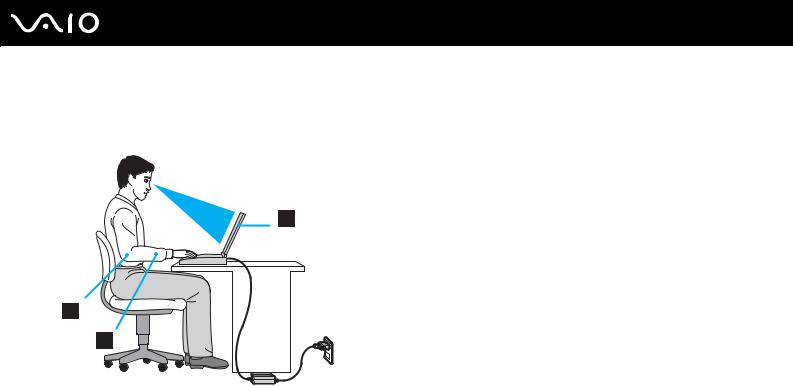
n 10 N
Before Use
Ergonomic Considerations
You will be using your computer as a portable device in a variety of environments. Whenever possible, you should attempt to take account of the following ergonomic considerations for both stationary and portable environments:
Position of your computer – Place the computer directly in front of you (1). Keep your forearms horizontal (2), with your wrists in a neutral, comfortable position (3) while using the keyboard, touch pad, or external mouse. Let your upper arms hang naturally at your sides. Take frequent breaks while using your computer. Excessive use of the computer may strain eyes, muscles, or tendons.
Furniture and posture – Sit in a chair with good back support. Adjust the level of the chair so your feet are flat on the floor. A footrest may make you more comfortable. Sit in a relaxed, upright posture and avoid slouching forward or leaning far backwards.

n 11 N
Before Use
Viewing angle of the computer's display – Use the display's tilting feature to find the best position. You can reduce eye strain and muscle fatigue by adjusting the tilt of the display to the proper position. Adjust the brightness level of the display as well.
Lighting – Choose a location where windows and lights do not cause glare and reflection on the display. Use indirect lighting to avoid bright spots on the display. Proper lighting adds to your comfort and work efficiency.
Positioning an external display – When using an external display, set the display at a comfortable viewing distance. Make sure the display screen is at eye level or slightly lower when you are sitting in front of the monitor.

n 12 N
Getting Started
Getting Started
This section describes how to get started using your VAIO computer.
!
Before starting your computer for the first time, do not connect any other hardware that did not originally come with your computer. Be sure to start up your computer with only the supplied accessories connected and set up your system. Upon completion, connect one device (for example, a printer, an external hard disk drive, a scanner, and so on) at a time, following the manufacturers' instructions.
Locating Controls and Ports (page 13)
About the Indicator Lights (page 19)
Connecting a Power Source (page 21)
Using the Battery Pack (page 22)
Shutting Down Your Computer Safely (page 30)
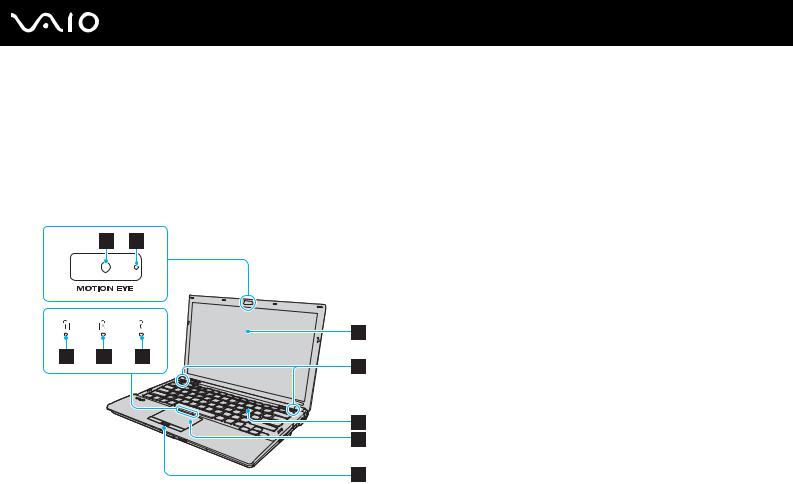
n 13 N
Getting Started
Locating Controls and Ports
Take a moment to identify the controls and ports shown on the following pages.
!
The appearance of your computer may be different from those illustrated in this manual due to variations in specifications. It may also vary in some countries or areas.
Front
A Built-in MOTION EYE camera (page 36)
B Built-in MOTION EYE camera indicator (page 19)
C Num lock indicator (page 19)
D Caps lock indicator (page 19)
E Scroll lock indicator (page 19)
F LCD screen (page 156)
G Built-in speakers (stereo)
H Keyboard (page 32)
I Touch pad (page 34)
J Fingerprint sensor (page 120)
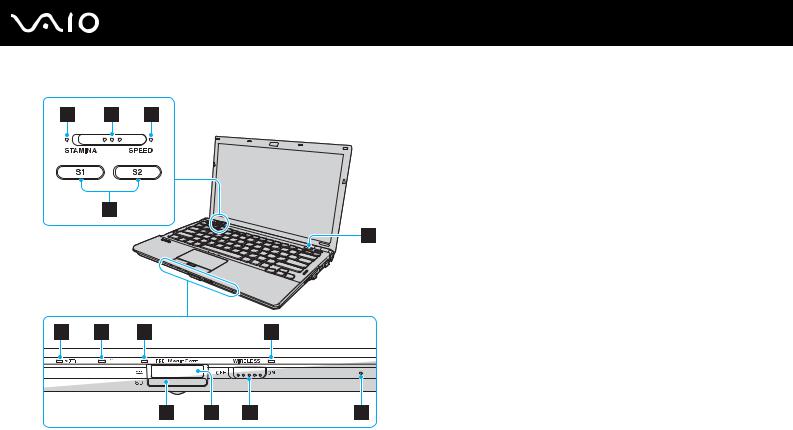
n 14 N
Getting Started
A STAMINA mode indicator (page 19)
B Performance selector switch (page 107)
C SPEED mode indicator (page 19)
D S1/S2 buttons (page 35)
E Drive eject button (page 35)
F Charge indicator (page 19)
G Hard disk drive*1/Optical disc drive indicator (page 19)
H Media Access indicator (page 19)
I WIRELESS indicator (page 19)
J SD memory card slot (page 58)
K Memory Stick slot*2 (page 52)
L WIRELESS switch (page 65)
M Built-in microphone (monaural)
*1 |
The storage device configuration of your computer may include a built-in |
|
flash memory storage drive depending on the model you purchased. See the |
|
online specifications to find out about your configuration. |
*2 |
Your computer supports both the standard-size Memory Stick and the Duo- |
|
size Memory Stick. |

n 15 N
Getting Started
Back
A Battery connector (page 22)
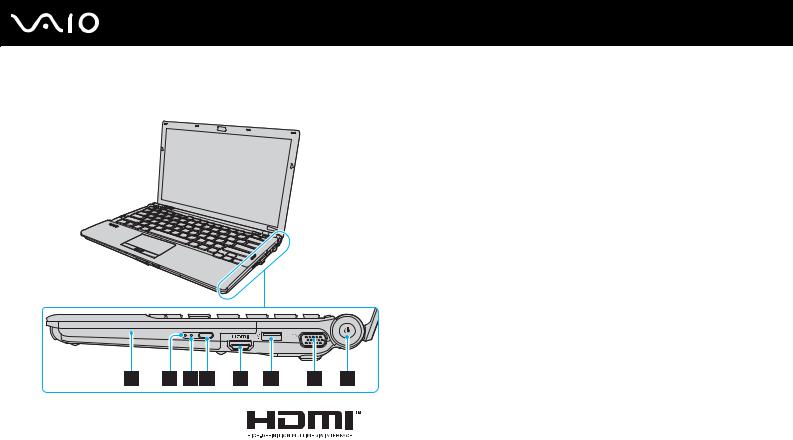
n 16 N
Getting Started
Right
A Optical disc drive (page 39)
B Optical disc drive indicator (page 19)
C Manual eject hole (page 193)
D Substitute drive eject button (page 39)
E HDMI output port*1 (page 89)
F Hi-Speed USB (USB 2.0) port*2 (page 100)
G Monitor port*3 (page 85)
H Power button/Power indicator (page 19)
*1 Functional only when your computer is in SPEED mode.
*2 Supports high-/full-/low- speeds.
*3 Not accessible when your computer is attached to the docking station.

n 17 N
Getting Started
Left
A DC IN port (page 21)
B Network (Ethernet) port (page 63)
C Air vent
D ExpressCard/34 slot (page 49)
E Security slot
F Modem port (page 61)
G Hi-Speed USB (USB 2.0) port* (page 100)
H i.LINK 4-pin (S400) port (page 104)
I Microphone jack (page 99)
J Headphones jack (page 83)
* Supports high-/full-/low- speeds.

n 18 N
Getting Started
Bottom
A Docking station connector (page 77)
B Air vents
C Memory module compartment cover (page 149)

n 19 N
Getting Started
About the Indicator Lights
Your computer is equipped with the following indicator lights:
Indicator |
Functions |
|
|
|
|
Power 1 |
Illuminates in green when the computer is on, blinks slowly in orange while the computer is in Sleep mode, and |
|
|
turns off when the computer is off or in Hibernate mode. |
|
|
|
|
Charge |
Illuminates while the battery pack is charging. See Charging the Battery Pack (page 25) for more information. |
|
|
|
|
Media Access |
Illuminates while data is being read from or written to a memory card. (Do not place the computer into Sleep |
|
|
mode or turn it off when this indicator is lit.) When the indicator is unlit, the memory card is not in use. |
|
|
|
|
Built-in MOTION EYE camera |
Illuminates while the built-in MOTION EYE camera is in use. |
|
|
|
|
STAMINA mode |
Illuminates while the computer is in STAMINA mode to conserve battery power. |
|
|
|
|
SPEED mode |
Illuminates while the computer is in SPEED mode to provide faster performance. |
|
|
|
|
Optical disc drive |
Illuminates while the drive is reading or writing data. When the indicator is unlit, the optical disc media is not in |
|
|
use. |
|
|
|
|
Hard disk drive*/ |
Illuminates while the drive is reading or writing data. Do not place the computer into Sleep mode or turn it off |
|
Optical disc drive |
when this indicator is lit. |
|
|
||
|
|
|
Num lock |
Press the Num Lk key to activate the numeric keypad. Press it a second time to deactivate the numeric keypad. |
|
The numeric keypad is not active when the indicator is unlit. |
||
|
||
|
|
|
Caps lock |
Press the Caps Lock key to type letters in uppercase. Letters appear in lowercase if you press the Shift key |
|
while the indicator is lit. Press the key a second time to turn off the indicator. Normal typing resumes when the |
||
|
||
|
Caps lock indicator is unlit. |
|
|
|
|
Scroll lock |
Press the Fn+Scr Lk keys to change how you scroll the display. Normal scrolling resumes when the Scroll lock |
|
indicator is unlit. The Scr Lk key functions differently depending on the program you are using and does not |
||
|
||
|
work with all programs. |
|
|
|

n 20 N
Getting Started
Indicator |
Functions |
|
|
WIRELESS |
Illuminates when the WIRELESS switch is turned on. |
|
|
*The storage device configuration of your computer may include a built-in flash memory storage drive depending on the model you purchased. See the online specifications to find out about your configuration.
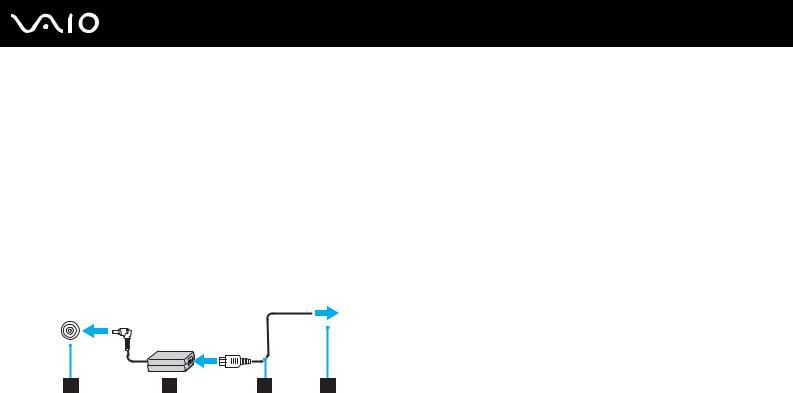
n 21 N
Getting Started
Connecting a Power Source
You can use either an AC adapter or a rechargeable battery pack for supplying power to your computer.
Using the AC Adapter
Use only the supplied AC adapter for your computer.
To use the AC adapter
1Plug one end of the power cord (1) into the AC adapter (3).
2Plug the other end of the power cord into an AC outlet (2).
3Plug the cable connected to the AC adapter (3) into the DC IN port (4) on the computer or on the optional docking station.
!
The shape of the DC In plug varies depending on the AC adapter.
To disconnect your computer completely from AC power, unplug the AC adapter.
Make sure that the AC outlet is easily accessible.
If you do not intend to use your computer for a long period of time, place the computer into Hibernate mode. See Using Hibernate Mode (page 143).
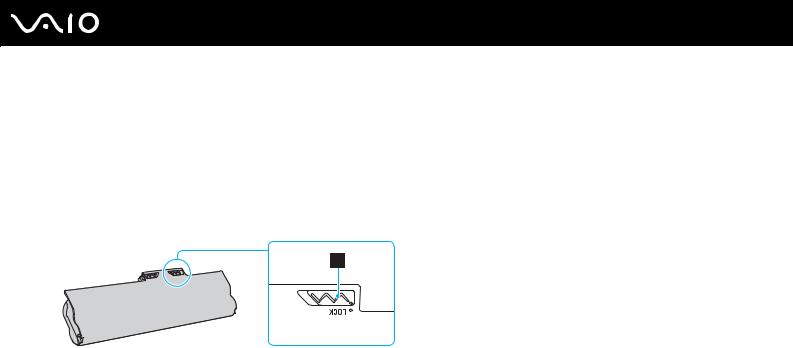
n 22 N
Getting Started
Using the Battery Pack
The battery pack supplied with your computer is not fully charged at the time of delivery.
Installing the Battery Pack
To install the battery pack
1Turn off the computer and close the LCD screen lid.
2Slide the battery LOCK switch (1) inward.
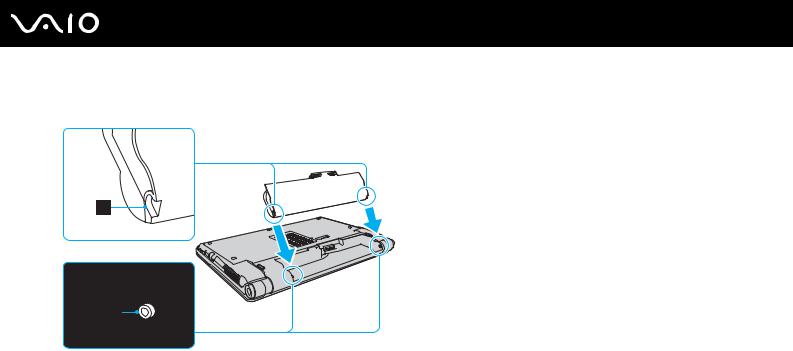
n 23 N
Getting Started
3Slide the battery pack diagonally into the battery compartment until the projections (2) on either side of the battery compartment fit into the U-shaped cuts (3) on either side of the battery pack.

n 24 N
Getting Started
4 Push the battery pack down into the compartment until it clicks into place.
5 Slide the battery LOCK switch outward to secure the battery pack on the computer.
When your computer is directly connected to AC power and has a battery pack installed, it uses power from the AC outlet.
!
This computer is designed to operate only with genuine Sony battery packs.

n 25 N
Getting Started
Charging the Battery Pack
The battery pack supplied with your computer is not fully charged at the time of delivery.
To charge the battery pack
1Install the battery pack.
2Connect the computer to a power source with the AC adapter.
The charge indicator light turns on while the battery pack is charging. When the battery pack charges close to the maximum charge level you selected with the battery charge functions, the charge indicator turns off. To select your desired maximum charge level, see Using the Battery Charge Functions (page 27).
Charge indicator status |
Meaning |
|
|
Lit in orange |
The battery pack is charging. |
|
|
Blinks along with the green power |
The battery pack is running out of power. (Normal |
indicator |
mode) |
|
|
Blinks along with the orange power |
The battery pack is running out of power. (Sleep mode) |
indicator |
|
|
|
Blinks fast in orange |
A battery error has occurred due to a failed battery |
|
pack or an unlocked battery pack. |
|
|
!
Charge the battery pack as described in this manual from your first battery charge.

n 26 N
Getting Started
Keep the battery pack in your computer while it is directly connected to AC power. The battery pack continues to charge while you are using the computer.
If the battery charge level falls below 10%, you should either connect the AC adapter to recharge the battery pack or shut down your computer and install a fully charged battery pack.
Your computer is supplied with a lithium ion battery pack and can be recharged any time. Charging a partially discharged battery pack does not affect the life of battery.
While some software applications or peripheral devices are in use, your computer may not enter Hibernate mode even when the remaining battery life is short. To avoid loss of data when using battery power, you should save your data frequently and manually activate a power management mode, such as Sleep or Hibernate.
If the battery pack wears out when the computer enters Sleep mode, you will lose all unsaved data. Going back to the previous work state is impossible. To avoid loss of data, you should save your data frequently.
When your computer is directly connected to AC power and has a battery pack installed, it uses power from the AC outlet.

n 27 N
Getting Started
Using the Battery Charge Functions
You can customize the current battery charging method using the Battery Charge Functions. To make the life of battery longer, enable the battery care function.
To enable the battery care function
1Click Start, All Programs, and VAIO Control Center.
2Click Power Management and then Battery Charge Functions.
3Click Advanced.
4Click to select the Enable Battery Care Function check box.
5Select the desired maximum charge level.
6Click OK.
To check the battery charge capacity
Follow steps 1 to 3 in To enable the battery care function above and check detailed information. If the battery charge capacity is low, replace the battery pack with a new genuine Sony battery pack.

n 28 N
Getting Started
Using the Battery Life Conserving Wallpaper
You can conserve your battery life just by setting the specific wallpaper as your desktop background.
To set the battery life conserving wallpaper
1Click Start, All Programs, and VAIO Control Center.
2Click Display and then Long Battery Life Wallpaper Setting.
3Click Set Long Battery Life Wallpaper. At the confirmation prompt, click OK.
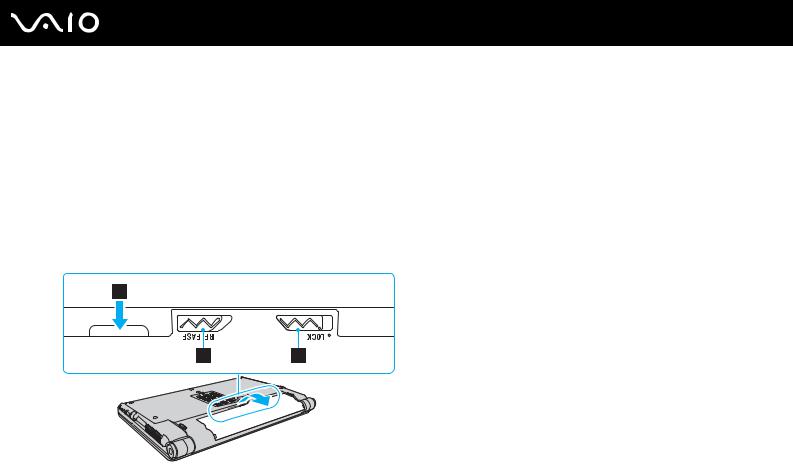
n 29 N
Getting Started
Removing the Battery Pack
!
You may lose data if you remove the battery pack while your computer is on and not connected to the AC adapter or if you remove the battery pack while the computer is in Sleep mode.
To remove the battery pack
1Turn off the computer and close the LCD screen lid.
2Slide the battery LOCK switch (1) inward.
3Slide and hold the battery RELEASE latch (2) inward, put your fingertip underneath the tab (3) on the battery pack, and lift the battery pack in the direction of the arrow, and then slide it away from the computer.

n 30 N
Getting Started
Shutting Down Your Computer Safely
To avoid losing unsaved data, be sure to shut down your computer properly, as described below.
To shut down your computer
1Turn off any peripherals connected to the computer.
2Click Start, the arrow  next to the Lock button, and then Shut Down.
next to the Lock button, and then Shut Down.
3Respond to any prompts warning you to save documents or to consider other users and wait for the computer to turn off automatically.
The power indicator light turns off.
